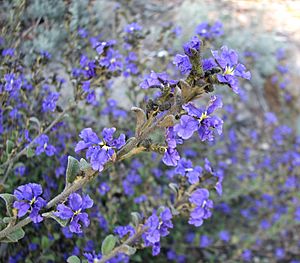Mountain- facts for kids
Quick facts for kids Mountain- |
|
|---|---|
 |
|
| Scientific classification | |
| Genus: |
Dampiera
|
| Species: |
purpurea
|
| Synonyms | |
|
|
The purple dampiera (Dampiera purpurea) is a beautiful plant found in eastern Australia. It grows in places like Victoria, New South Wales, and Queensland. This plant is a type of small shrub. It has lovely blue-purple flowers that bloom from September to December. Bees and butterflies help pollinate its flowers. Many people also grow the purple dampiera in their gardens.
Contents
About Its Name
Scientists give every plant a special name. This helps everyone know exactly which plant they are talking about. A famous botanist named Robert Brown first described the purple dampiera in 1810. He wrote about it in his book, Prodromus Florae Novae Hollandiae et Insulae Van Diemen.
The plant's scientific name, purpurea, comes from a Latin word. It means "purple," which perfectly describes its pretty flowers.
What It Looks Like
The purple dampiera is a plant that stands upright. It can grow up to about 1 meter (3 feet) tall. It has many stems. Its leaves are shaped like an oval or a spoon. They can be from 0.9 to 6 centimeters (0.35 to 2.4 inches) long. The leaves are also 0.5 to 4.2 centimeters (0.2 to 1.7 inches) wide.
The stems and the underside of the leaves feel a bit rough. This is because they are covered in tiny hairs. But the top of the leaves become smooth when they are fully grown.
The flowers usually appear between August and January. They grow in groups of two to nine branches. Each group can have three to five flowers. These flowers are about 2.5 centimeters (1 inch) across. They are mostly blue-purple with yellow centers. Sometimes, you might even see pink or white flowers.
Where It Lives
The purple dampiera grows naturally in eastern Australia. You can find it in Victoria, New South Wales, and Queensland. It likes to live in certain types of forests and open areas. These places are called sclerophyll forests and heathlands.
In the Sydney area, it often grows under specific trees. These include the smooth-barked apple and yellow bloodwood. It also grows under red bloodwood and blackbutt trees. The plant prefers sandy soils that drain water well. However, it can sometimes grow in clay soils too. These areas usually get a good amount of rain each year.
How It Survives and Grows
The purple dampiera has a special way to survive bushfires. If a fire burns the plant, it doesn't die completely. New shoots can grow from the ground level. These new shoots can even produce flowers within ten months. They bloom best about two to three years after a fire. The plant also grows new plants from its seeds after a fire.
Insects play a big role in the plant's life cycle. Butterflies, including those from the Lycaenidae and Hesperiidae families, visit the flowers. European honeybees also come to collect nectar. These insects help to pollinate the flowers. This means they help the plant make new seeds.
Growing It in Your Garden
The purple dampiera is a great plant for gardens. It can grow in many different climates. This includes cool places and warmer, subtropical areas. There are many different types of this plant that people grow.
It likes a spot with some shade. But it can also grow well in full sunlight. It can even handle a little bit of frost. This plant can grow in most soils that drain water well. However, it grows even better in heavier soils.
To get the best results, give it enough water in spring and summer. Once it's settled, it can handle dry periods. After the flowers fade, you can trim the plant lightly. This helps it keep a nice shape. You can grow new plants from cuttings or by dividing an existing plant.

